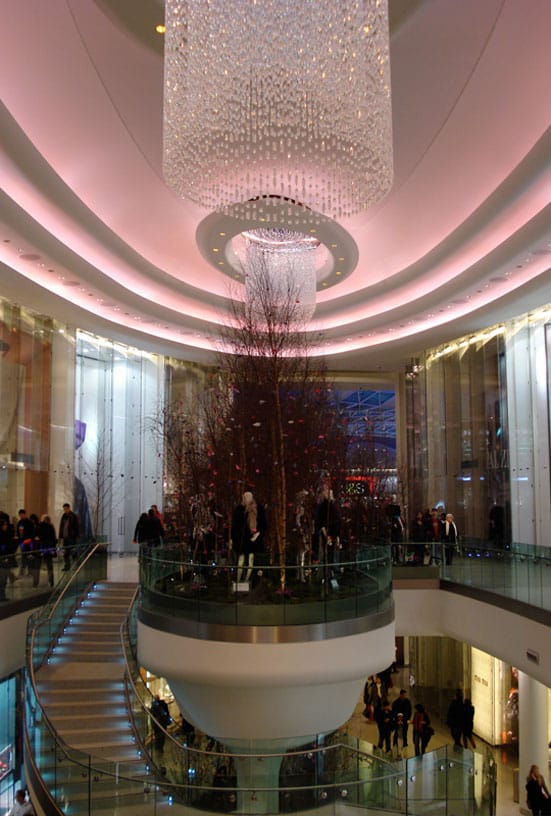Address: Ariel Way, W12 7GF
Times: Monday – Wednesday 10am - 9pm, Thursday - Friday 10am - 10pm, Saturday 9am - 9pm, Sun 12pm - 6pm
The new Westfield shopping centre in Shepherds Bush seems either too big, or too removed from reality to be affected by an economic downturn. The idea of the forces behind such a huge development stopping for one second to consider the wisdom of opening a huge retail centre in the midst of a crisis – hitting that very industry especially hard – seems slightly absurd. There are things here, and those things will be sold. Money will be wrung out, even from where there appears to be none. On the 31st of December 2008, the walkways of Westfield London are teeming with people, and not people aimlessly wandering or strolling: people marching; striding – covering ground. Isn't shopping supposed to be dying?
The whole enterprise of mall building seems to rely on constant 'New' – the draw of a New Place, to pull customers away from whatever old high street or mall they were previously frequenting, and into the shiny, fresh spaces of this New Mall. With this in mind, even in a place as brashly new as Westfield, it is hard not to think of an inevitable decline when it will be replaced as top mall by an even bigger, brighter successor. My first memories of this kind of 'under one roof' shopping are of Runcorn Shopping City, built in 1972 and well on its way to being decidedly shabby by the early nineties when I used to visit. At the time it was built, this too must have been the New thing, top dog of shopping centres in the area.
Westfield London is as clear an example of 'non-place' as I have ever encountered. It immediately reminds me of an airport in its architecture and scale. Westfield is, of course, an international chain of malls – the blueprint used here is replicated all over the world. The high roof covers multiple levels of bright shops, wide walkways are punctuated by small groups of tables and chairs, often accompanied by potted plants. Here people who have dropped away from the marching shoppers doze or stare into space. The toilets are beautiful. Phalanxes of plastic mannequins are admirably stylish in their attire. Members of the security staff are subtly dispersed in nondescript black suits, gently pressing their ears and talking to themselves.
The difference between the 'inside' of a shop and the 'outside' of the mall are blurred here, as much defined by the differing piped music as by any physical boundary; huge glass walls are decorated with grey dots to stop you blundering straight into them. The question 'Eat in or take away?' becomes difficult to grasp. The layout at Westfield is disorientating, designed to give the impression of potentially endless shopping. A dead end will never be reached, the browser will always be deflected to the side, or up or down. The strange effect of walking without a real sense of direction, without geography, lulls one into a state where this seems like an attractive proposition: walk; eat; drink; look at things into infinity. Perhaps this is the tactic that will see Westfield through an economic collapse – offering temporary escape from not only geographical space but also time. It seems very apt that malls like this include cinemas on their upper levels; an audience already made open to commercial suggestion spiral upwards towards the drip-feed of sugar and industrial entertainment in the multiplex.
Despite the implacable confidence of an international chain of expensive malls, with such grim predictions for the high street in 2009, I can't help wondering how many of these stores will be empty by this time next year. Something tells me that an empty storefront would simply not be allowed to occur on the walkways of Westfield; its bosses would find a way to fill it, they would invent a stand in chain themselves, like Hollywood's 'Alan Smithee', the fabricated moniker that stands in for a director who has fled a production.
As the lights dim to replicate a sunset, conveniently coinciding with closing time today, I can't help being quite disappointed with Westfield. I went expecting super-modern spectacle; I expected Starbucks to be in the shape of a coffee mug and the paving slabs to look like credit cards. In fact it was all horribly familiar and ordinary. Compliance with the architecture of the place and therefore also the plan for your behaviour within it becomes attractive – I feel a need to have a wool rich cardigan, a glass of wine, a plate of sushi. Looking for novelty, I only found global business still ticking over, smooth and noiseless.
Richard Whitby

Westfield, London, photo by Richard Whitby